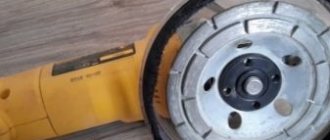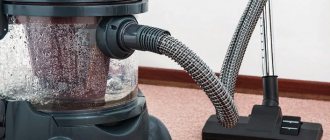Very often, when doing electrical installation work, it is impossible to do without a vacuum cleaner.
This is primarily due to the processes of wall gating. You cannot use homemade household models for this task, otherwise you will ruin them on the very first day of work. Their dust collectors will fill up very quickly, and the vacuum cleaner itself will overheat.
Only professional craftsmen who earn a daily living from this type of activity can afford to buy a construction equipment, which costs quite a lot of money.
But what if you are not a builder and you only need such a device to complete electrical repairs in your apartment? In this case, there is only one optimal solution - to make a construction vacuum cleaner yourself from an ordinary one.
Moreover, such a change will only take you a few minutes. And the materials that are required for this can be easily found in the pantry, or purchased in addition at the nearest plumbing store.
Let's take a closer look at two very similar methods, which nevertheless have structural differences between each other.
Homemade cyclone from a household vacuum cleaner
The first method has been presented on the Internet and on YouTube for quite some time. You can easily find many videos with similar homemade cyclones.
However, they raise quite natural questions and skepticism among professional builders. Therefore, it should be noted right away that they are mostly suitable for removing wood chips.
But it is better not to work with cement dust with such devices. The second option is more tailored to it.
The main “trick” that will allow you to easily suck in kilograms of garbage, wood, and metal filings and not worry about frequently changing filter bags is a homemade “separator”.
It will then need to be constructed from several components. For the entire assembly you will need:
- regular vacuum cleaner
- thick plastic bucket with lid
A bucket of Shitrok putty is best suited here. It is harder to flatten it with a vacuum.
- plastic sewer pipe d-40mm
- polypropylene sewer outlet at 90 degrees with a diameter of 40mm
- 40mm crown or utility knife
First of all, drill or carefully cut a through hole for the tube in the center of the bucket lid.
Mark the third hole closer to the edges of the cover, where the stiffener is.
If you do not have a special crown, then first pierce the intended circle with an awl and carefully cut it with a stationery knife.
The edges will be uneven, but they can be processed with a round file.
Two sewer outlets are inserted into these holes. So that they hold securely and there is no additional air leakage, it is better to glue them.
To do this, first sand the edges of the tube with sandpaper or a file to create a rough surface.
Do the same operation with the lid.
After this, insert the tube into the inside of the cap and apply a thick layer of glue with a hot-melt gun.
Don't skimp on glue. This will help create a good seal in these places and tightly close all the cracks.
There is actually another option in which you can do without glue and fan pipes altogether. To do this, purchase rubber adapter couplings from Leroy Merlin.
They come in different diameters. Select according to the size of your hose.
For example, a tube from a 35mm hose is tightly inserted into a 40/32 coupling. But in a 40mm pipe it will dangle. We'll have to reel in something and collective farm.
On the tube that is located on the edge of the lid, place the sewer outlet at 90 degrees.
At this point, the separator design can be said to be almost ready. Install the lid with outlets on the bucket.
The air intake hose from the vacuum cleaner is inserted into the central hole.
And the piece that you will use to collect all the debris and dust is stuck into the corner joint.
It is desirable that the tubes contain sealing rings that match the size of the corrugated hoses of the vacuum cleaner.
This completes the entire assembly. You can plug in the vacuum cleaner and use it.
Here is a visual video of the inside of a bucket of a similar design. It clearly shows how sawdust is sucked into the separator, but cannot escape from it and get into the vacuum cleaner.
The operating principle here is as follows. Coarse dust sucked into the container falls to the bottom of the container. At the same time, it does not enter the area where air is pumped directly.
Three factors help in this matter:
- gravity
- friction
- centrifugal force
They then make the garbage rotate inside the bucket, pressing against its walls, and then fall to the bottom. And only the fine fraction goes directly into the dust collector of the vacuum cleaner.
Typically, such a cyclone in factory designs has the shape of a cone, but cylindrical specimens also often cope well with this task.
True, the higher the bucket, the better the installation will work. Much here depends on the correct combination of the design of the container and the power of the vacuum cleaner. Here is a sign from Chinese cyclones on the correct selection of hose diameter and unit power.
In cylindrical buckets, the tangential air flow enters not through the curved side wall, but through the flat lid. Assembling such a device is much easier.
Also, if you have several buckets, you can use them alternately. Just remove the lid from one and move it to the other. Moreover, this is even easier to do than in bulky cyclones.
Then, at the very end of the work, simply take out the filled containers at once. This is a great time saver.
If you have a powerful vacuum cleaner, instead of a plastic bucket for emulsion paint, it is better to use a metal tank of the same shape. Otherwise, the bucket will collapse and flatten it.
The power regulator helps in this matter. If, of course, it is present in your model.
Spray gun holder
A paint sprayer is an important assistant in carrying out various works. However, since the process can be quite lengthy and require breaks, a tool such as a spray gun holder will play the role of a necessary tool. It will not only help you place the sprayer carefully, without spilling the paint, but will also ensure its safe storage.
In order to make a holder for a spray gun at home you will need:
- a piece of wire (it is better to initially take with a reserve - about 1.7 m);
- any round part (to form “horns”), for example a part from a bearing;
- pliers;
- scotch.
Construction includes the following stages:
- First of all, the middle of a piece of wire is determined, after which a round part is placed in this place and the horns of the device are made, which are then formed using pliers.
- All elements are fixed using tape. During the manufacturing process, the correctness of the shape is checked by installing the spray gun in the holder.
Why does the vacuum cleaner still fail?
With this method, all the fine dust will enter the vacuum cleaner bag, and more or less large fractions will simply settle and remain in the bucket. As do-it-yourselfers assure, more than 95% of construction waste settles in the separator and only 5% goes directly into the dust collector of a household vacuum cleaner.
However, the thing is that even this 5% can gradually kill the vacuum cleaner. In addition, even for industrial cyclones, the declared efficiency is rarely more than 90%, but what about home-made products, in which the aerodynamics are far from perfect.
For 100% collection of the fine fraction, an electric precipitator or bubble column is needed.
By the way, some types of dust cause very strong static voltage. Be careful when working.
The longer you work with the unit without unplugging it, the higher the charge may be. Here, read the instructive commentary of one real user of such a homemade product.
Therefore, on many cyclones, even factory-assembled ones, the flange is grounded.
Five percent of fine wood chips is certainly not dangerous for a household vacuum cleaner. What if it is fine cement dust during gating?
When such particles get inside, they clog the filter tightly.
And this happens very quickly. The entire efficiency of the “cyclone” drops by at least 2/3 within a matter of minutes.
The main problem is the dust bag. It is dense and the filtration area is small. Therefore, it is not suitable for waste from plaster and concrete walls.
What to do? Is it really impossible to do without a real construction project? During intensive work, only an expensive and professional tool really saves you.
How to make an air compressor with your own hands: design options
It is not necessary to buy a compressor for painting work or inflating wheels - you can make it yourself from used parts and assemblies removed from old equipment.
We will tell you about structures that are assembled from scrap materials. In order to make a compressor from used parts and assemblies, you need to be well prepared: study the diagram, find it on the farm or buy some additional parts. Let's consider several possible options for independently designing an air compressor.
What is the difference between a construction vacuum cleaner and a regular one?
But for occasional work, this design can be slightly modified and improved. The idea belongs to Andrey Shayter.
Before we look at the second design option, ask yourself the question: “What is one of the main differences between household vacuum cleaners and construction vacuum cleaners?”
In domestic models, cooling occurs due to the intake air.
That is, you vacuum the floor, the air sucks in debris. Next, it is filtered and cooled by the engine itself. After which the air is thrown out.
This is where the risk of engine damage comes from. Firstly, when the filter becomes clogged, engine cooling drops sharply.
Secondly, cement dust is 100% not retained in the dust collector, and some of it flies through the windings, along the way removing the varnish insulation like sandpaper. Such dispersed dust kills everything that rubs and rotates.
Adding water to the bottom of the tank doesn't really help. Instead of dust, you will get a lot of dirt, the weight of the bucket, and the filters will still eventually become clogged.
In professional devices, the engine is cooled separately, through special technological holes. Therefore, they are not so afraid of bags completely filled with garbage.
Moreover, they also have automatic cleaning or shaking.
In order to intelligently remake a household model, you will need a little more spare parts than in the first case.
Independent process
You can make a construction unit for cleaning rooms from complex debris on the basis of an old Soviet vacuum cleaner. For example, this could be the Ural PN-600 model.
To achieve this you will need the following arsenal:
- Designated vacuum cleaner model.
- Bulgarian.
- Pipe element.
- Plastic bucket. Requirements for it: tight lid, durable handle.
- Insulating tape.
- Scotch.
- Electric drill.
- Set of self-tapping screws.
- Special glue.
- Bandage (you can also use gauze).
At the initial stage, it is necessary to finalize the design of the waste collection container. You'll need a screwdriver here. With its help, the wheels are eliminated. The resulting holes must be sealed with tape.
A screwdriver is also used to remove the nameplate. The fastening area is sealed in the same way. Before removing the rivets and latches, it is necessary to remove the retaining components from the springs. Having eliminated them, install the plug. Wrap it with electrical tape.
You need to make a hole in the bottom. The required diameter is 4.3 cm. A drill is used. This is where you will need gaskets. Their wall density is 4 mm. To create them, sealing material is used.
This was a range of preparatory actions. Next, you can begin the assembly process.
The elements and materials used, according to the design, are arranged as follows:
A spigot, a lid, and a spigot are placed in the converted waste container.
A drill with a diameter of 2 mm is inserted into the drill. Holes are drilled with this tool. The cover is fixed with self-tapping screws. Their optimal parameters are 42 x 1 cm.
After which you will need a hole for installing a special pipe. It is also called suction. Metal scissors are used here. After installation, the pipe is fixed using self-tapping screws.
Between this element and the body there is a connection that needs to be sealed. A simple bandage or gauze is used, only they need to be soaked with glue. Suitable brands of glue are “Titan” and “Dragon”.
When you leave the created device for storage, do not cover it under any circumstances. This may result in dust entering the device.
Working version of a construction vacuum cleaner from a household one
The main additional element here is a filter bag made of non-woven material. Instances from Karcher are very suitable - article number 2.863-006.0
Actually, this filter is disposable. Your task is to make a reusable element out of it.
To do this, cut its lower part and fold it a little, slightly reducing the width (up to 22cm).
Next, this lower part needs to be closed with a special lid. You make it from two elements of a plastic cable channel and a piece of polypropylene pipe.
Saw the tube lengthwise, with a slot width of approximately 5mm.
Everything else is simple. Apply glue to the lids.
Apply them with the back side to the fabric at the bottom.
Then insert the prepared tube through the slot.
As a result, from a disposable one you have a reusable filter bag. Moreover, it is much larger than the one installed inside the household model.
Next, you go through the previously discussed steps to modernize the bucket. Drill holes in the lid and insert rubber corrugated adapters into them.
One will be for connecting the filter bag, the other will be for the hose. Select the sizes according to the diameters of your devices.
Here you can do without fan pipes and corners. Next, place the plastic insert from the reusable filter onto the adapter.
All that remains is to tightly close the lid on the bucket. The structure is ready for use.
Although it is similar, it differs from the first option above. After you turn on the unit and begin to suck in debris, it is the homemade reusable dust collector that will collect all the muck and dirt.
Dust will not fly around as in the previous case. On the contrary, this bag will swell inside the bucket due to the air flow.
Gradually it will be filled with both heavy and small fractions that could have been missed by the cyclone.
However, do not forget about clogging the walls of the reusable filter and reducing the draft of the cooling air flow. In order not to burn out the motor of a household vacuum cleaner, it is necessary to carry out one more action.
Compressor or turbocharger
So, let's start with the latter and try to figure out what is suitable for the VAZ 2107 - turbocharging or a mechanical compressor. Initially, experienced drivers, regardless of the VAZ model, advise using a compressor to increase the car’s power.
Moreover, according to experts, you need to be guided by the following advantages of the compressor:
- During installation, minimal modifications to the internal combustion engine will be required.
- The actual ease of installation of the device.
- When installing a compressor, you will not have to interfere with the operation of the lubrication and cooling systems; accordingly, the exhaust manifold will not overheat, as is the case with gas turbine supercharging.
Installing a turbine is justified on a modern imported high-speed car, which was initially designed for high power. In the case of a VAZ, the turbine will simply “kill” the engine or injector, and this will happen in a very short time. Therefore, in order to eliminate all risks for the VAZ 2107, it is initially worth considering only a mechanical compressor.
Article on the topic: Robot vacuum cleaner that talks
Today, there are two ways to tune the 2107 internal combustion engine: experimental or purchasing a ready-made kit. Each of them deserves a separate discussion. Therefore, first things first.
Device Features
As a rule, the air stream should be cleared of debris and passed through a container of water or a cloth filter. This will be quite enough to retain dust and small household debris. The vacuum cleaner for sawdust and shavings has a slightly different design.
It does not have a fabric filter, because it will only create unnecessary resistance to air flow.
Wood shavings, sawdust and dust should be removed from the air ceiling into a centrifugal force apparatus, namely a cyclone. In most large industries, industrial-type chip vacuum cleaners are used to suck out large sawdust and shavings and the working area of a wood processing machine. These are large devices with incredible power, although they are designed in the same way as small carpentry-type vacuum cleaners.
Mechanical engine charging: what you need to know
Let's start with the fact that installation of any type of supercharger (mechanical or turbocharging) is possible on both injection and carburetor engines. In both cases, a number of modifications to the power unit are expected, however, installing a turbine on the engine is somewhat more difficult and expensive compared to a compressor.
It becomes clear that a mechanical supercharger is a more affordable way to increase engine power; such a solution is easier to install on the engine, and the work can even be done independently. At the same time, the general principle of operation of the supercharger is quite simple.
The device can actually be compared to an attachment (generator, power steering pump or air conditioning compressor), that is, the unit is driven by the engine. As a result of the operation of a mechanical compressor, the air is compressed and enters the cylinders under pressure.
Related article: How to use a neff dishwasher
This allows the cylinders to be better purged (ventilated) from exhaust gas residues, cylinder filling is significantly improved, the amount of air in the combustion chamber increases, which makes it possible to burn more fuel and increase engine power.
Also, the compressor has a direct dependence on engine speed. The more the engine is revved, the more air is supplied to the combustion chambers and, accordingly, the power increases. At the same time, there is no pronounced effect of turbojam (turbolag), which is found on turbocharged engines. Turbo lag manifests itself in the form of a failure at low speeds, when the exhaust energy is not yet enough to spin the turbine and create the necessary pressure to effectively supply air to the cylinders.
In other words, all work is carried out comprehensively, which further allows the forced power unit to operate successfully and stably without significantly reducing its service life. Now let's look at some of the features of this installation.
Features of choice
If it seems to you that making a chip ejector yourself will be difficult, you can choose from existing models. When choosing a vacuum cleaner for removing sawdust and shavings, it is first important to decide what type of dirt you will be removing. If you usually work on metal, then you will need to think about purchasing or even creating a powerful stationary device.
But as a carpentry vacuum cleaner that will remove wood dust and shavings, small mobile units with long flexible hoses are usually used. In a large number of cases, the designs of hand-held woodworking tools already have connections for connecting a suction hose with a standard size of 3.4 cm, and this exactly corresponds to the size of a household vacuum cleaner hose.
Where is vacuum used?
The manufacture of vacuum pumps is of interest to home craftsmen who know how to use them. For most ordinary people, the unit is of no value. In fact, with the help of air pumping, many useful things are realized:
- Long-term storage of clothes and food. Just put them in a plastic bag, connect the pump and immediately seal them. The packaging will turn into a reliable container, free of bacteria and harmful microorganisms.
- Vacuum canning in jars.
- Filtration of various solutions through the smallest meshes.
- Removing air and moisture from the evaporator and condenser units when installing a domestic air conditioner.
- Oil extraction when repairing an automobile diesel or gasoline engine.
Similar devices are also used for vacuum body massage and operation of machines - presses, packers and molders.
Making a ring and insert
- Cut off the side of a small plastic bucket.
- Having placed the container on the plywood, you need to circle its bottom and determine the center of the resulting circle. To find the center, it is enough to draw 2 perpendiculars to the drawn tangents.
- Another circle is drawn 30 mm larger than the first.
- Using a jigsaw, cut out a ring along the drawn circles.
Reason for markdown
The 3 in 1 car vacuum cleaner PROFFI (vacuum cleaner, compressor, flashlight) is a compact portable device designed for cleaning dust and dirt from the surfaces of the car interior and trunk by suctioning the air flow. The compressor will help inflate the car’s tire, even if you are in difficult conditions and there are no service stations nearby (the compressor’s continuous operating time is 10 minutes). The vacuum cleaner is powered by a machine battery and is equipped with a small dust collector. The input voltage is 12 V, the power of the vacuum cleaner is 60 W, and the power of the compressor is 80 W. The kit also includes a 3-meter cord with an adapter for lighting a car. Air temperature range for product operation: from - 20C to +60C. Such a car vacuum cleaner will be a wonderful gift for every car enthusiast (both men and women).
Article on the topic: A refrigerator that orders food itself
General characteristics
Nutrition
Technical features
Other features
Additional Information
| Model | PA0330 |
| Guarantee period | 1 year |
| Nutrition | from a car battery |
| Dust container type | container |
| Type of cleaning | dry |
| Suction power | 60 W |
| Transportation | not dangerous cargo |
| Fragility | not fragile |
| Weight with packaging (kg) | 1.4 kg |
| Weight without packaging (kg) | 1.3 kg |
| Item height | 41 cm |
| Subject Depth | 11 cm |
| Item width | 12 cm |
| Packing width | 14 cm |
| Packing height | 45 cm |
| Packing depth | 15 cm |
| Country of Origin | China |
| Equipment | vacuum cleaner; hose; nozzles - 3 pcs. |
Information about technical characteristics, delivery set, country of manufacture and appearance of the product is for reference only and is based on the latest available information from the seller











